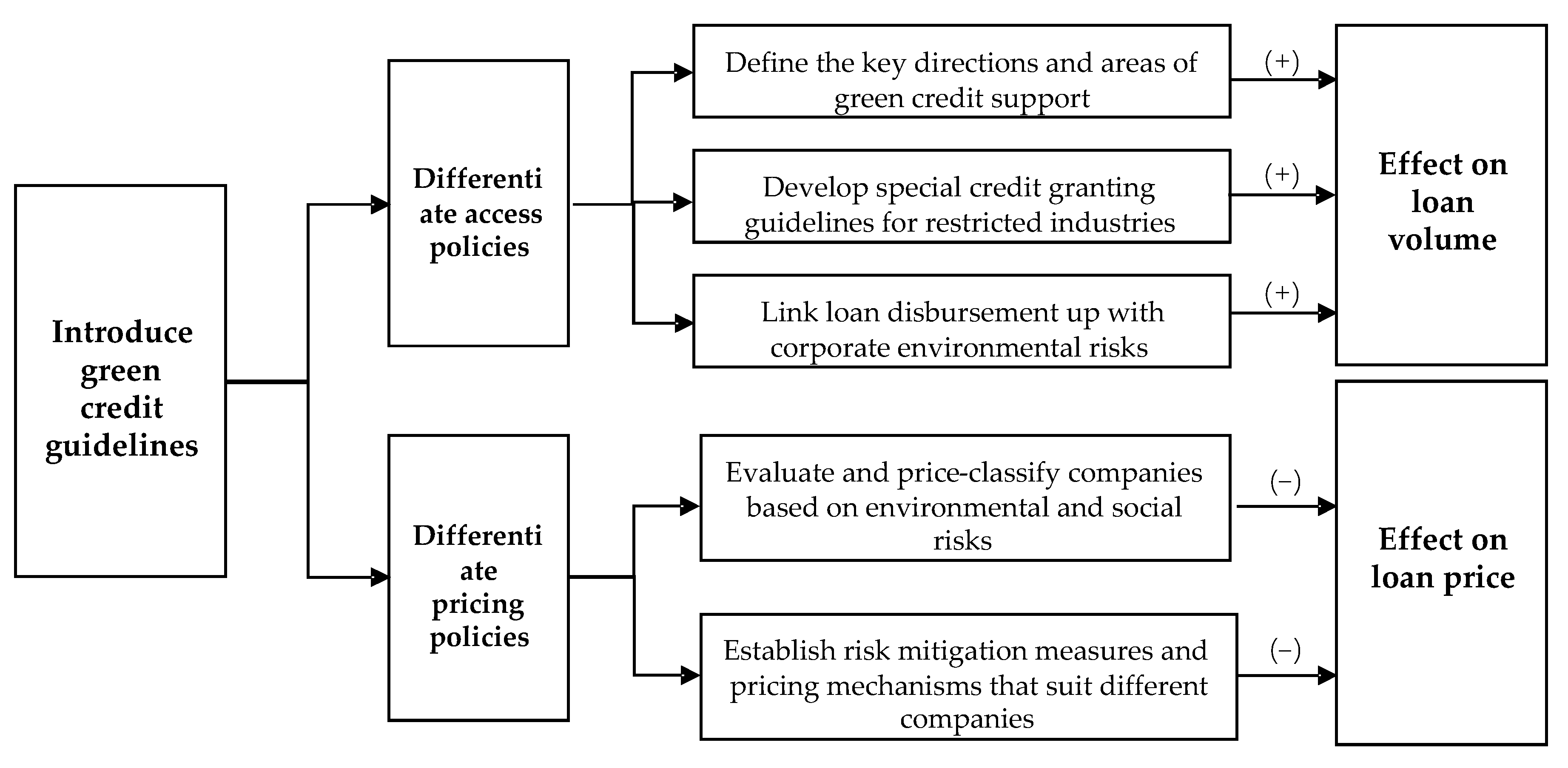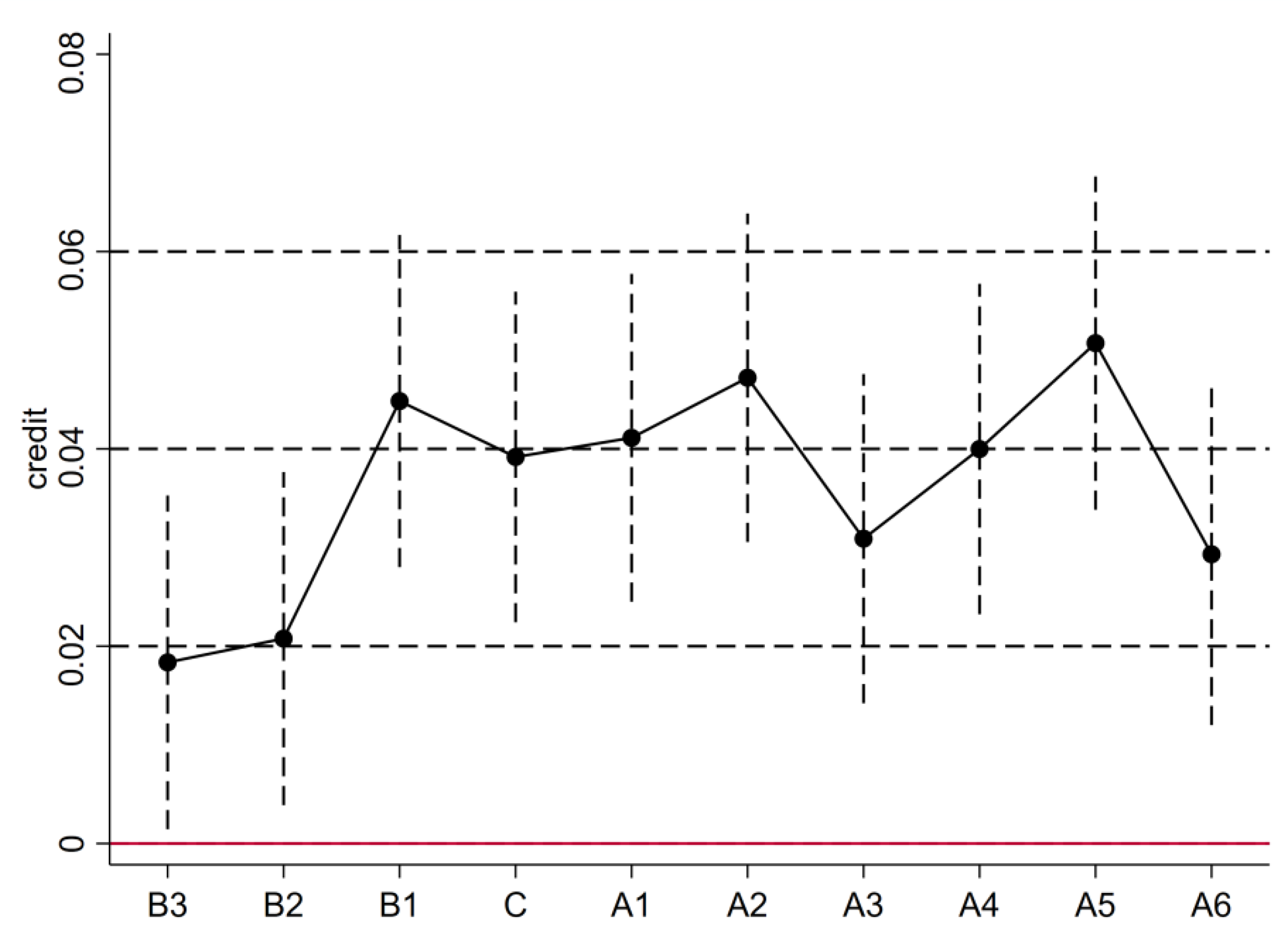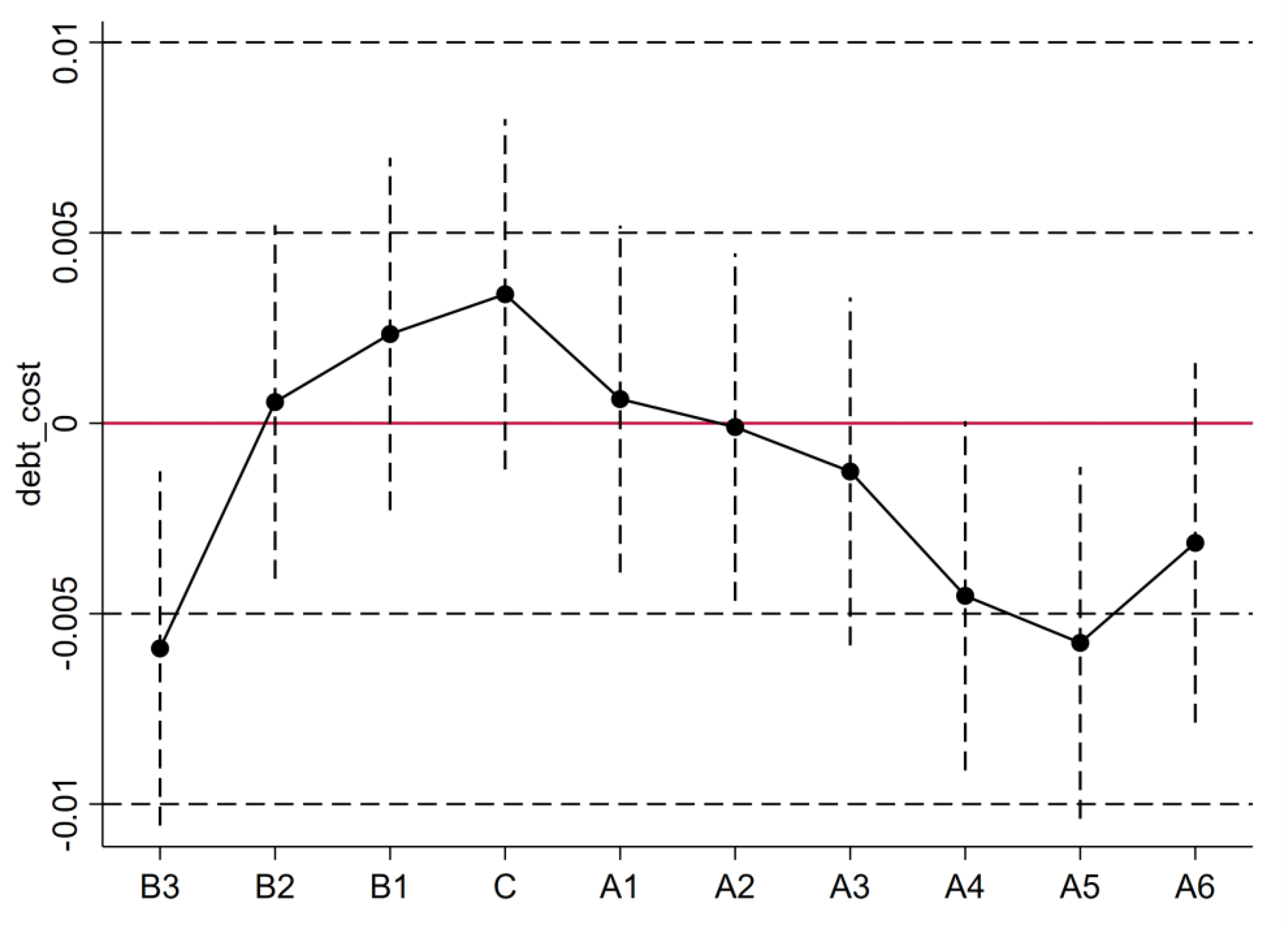1. Introduction
Under the development of industrialization and urbanization in China, ecological environment problems have become increasingly prominent. It has become the policy objectives of the Chinese government to promote economic transformation and upgrading by supporting the development of green industries, promoting industrial transformation and upgrading, and taking the road of sustainable development. Since the vast majority of green projects are private products with certain externalities rather than pure public products, the characteristic that externalities cannot be fully internalized leads to insufficient incentives for green investment (Ma and Shi, 2014; Ma, 2015) [
1,
2]. The existence of externalities makes the allocation of resources deviate from Pareto optimality. When there are serious externalities, it is difficult for the market to allocate resources rationally to obtain the best performance (Altenburg and Rodrik, 2014) [
3]. On the other hand, purely from the perspective of economic interests, corporate social responsibility usually conflicts with its own interests (Brammer et al., 2006; Van, 2017; Uadiale and Fagbemi, 2012) [
4,
5,
6], and enterprises that do not assume social responsibility or rarely assume social responsibility generally show better financial performance than responsible enterprises (Li et al., 2017) [
7]. Therefore, in addition to market constraints, the government and regulatory agencies are also required to assist in guiding the flow of resources from various policy levels, promote the development of green enterprises and promote environmental protection. In response to this problem, China has implemented a series of environmental regulation policies, such as green finance, green taxation and green procurement.
Green finance is essentially a financial form that can effectively allocate financial resources. The main function is to guide capital to industries with low energy consumption, low pollution and high efficiency, so as to promote the optimization of economic structure and realize a win-win situation between environment and economy (He et al., 2019) [
8]. In particular, green finance in countries in transition is essentially a rationing of financial resources based on environmental constraints and a mandatory institutional reform implemented by the government (Wang et al., 2019) [
9]. The main task of green finance in countries in transition is to realize the transformation from a high pollution and high energy consumption mode to a development mode of energy conservation, emission reduction, green, low carbon and high efficiency (Volz, 2018) [
10]. As a way of green finance, green credit is a financial innovation to effectively control environmental pollution (Labatt and White, 2002) [
11]. By studying the effect of policies, relevant scholars found that the green credit policy has the most significant effect in this series of green financial policies implemented in China (Aizawa and Yang, 2010) [
12]. Since the introduction of green credit policy into China, the Chinese government has actively promoted the formulation of relevant rules on green credit policy. Banks are required to introduce an enterprise environmental risk assessment mechanism in the loan review process, guide the whole society to consume energy and resources as low as possible and strictly control credit investment to enterprises in polluting energy consumption industries, which reverses environmental deterioration to the greatest extent, makes up the ecological shortage and promotes the sustainable development of society and environment. China’s policy document on green credit began with the release of the “Notice on Using Green Credit to Promote Environmental Protection” issued by the State Environmental Protection Administration in 1995 and matured with the release of the “Green Credit Guidelines” issued by the China Banking Regulatory Commission in 2012. The reason why this paper chose the “Green Credit Guidelines” issued on 24 February 2012 as the landmark event is that the document defines the standards and principles of green credit in the banking industry for the first time, and it provides detailed operational guidance on how financial institutions can effectively carry out green credit, promote green transformation of traditional industries and support the establishment of a low-carbon circular development industrial system. Since the document, China’s green credit policy has entered the stage of fine management and has begun to pay more and more attention to the implementation effect of the policy.
Since the “Green Credit Guidelines” were issued, China’s green credit has developed rapidly. Judging from the balance of green credit loans, the balance of loans has increased significantly. According to the data released by the China Banking Association, by the end of 2019, the green credit balance of 21 major banks in China had exceeded CNY 10 trillion, and a large amount of credit resources had flowed to green industrial enterprises (China Banking Association, 2019) [
13]. From the perspective of industrial adjustment, through the adjustment of the flow of credit resources, the green credit policy has accelerated the upgrading of industrial structure and promoted the green transformation and sustainable development of the economy (He et al., 2019) [
8]. The growth of the balance of green credit and the result of the adjustment of industrial structure show that the “Green Credit Guidelines” have realized the role of guiding financial resources and adjusting industrial structure, but these are the final results of the policy. In the process of exerting its effect, the policy needs to achieve its goal through the issuance of loans. There is still a lack of sufficient research on this intermediate process.
Collecting the relevant research, we find that the mainstream research focuses on its restraint mechanism and restraint effect. The original intention of the establishment of the green credit policy was to reduce the difficulty and cost of obtaining loans for green environmental protection enterprises by setting up access standards, thus realizing the inclination of credit resources to green enterprises and Pareto improvement of financial resources.
In terms of mechanisms of action, the green credit policy has established credit criteria for enterprises and classified credit management for the degree of impact of projects on the environment. Through credit rationing, under the condition of the same capital price, the capital investment for green projects is tilted and the capital investment for other projects is relatively reduced, thus realizing resource reallocation (Wang et al., 2019) [
9]. According to Stiglitz and Weiss (1981) classical theory of credit rationing, credit rationing is caused by information asymmetry. The problem of information asymmetry is highlighted as two major problems in the development of green finance: First is the adverse selection effect. The second is moral hazard. Due to adverse selection and moral hazard, polluting enterprises are theoretically willing to pay an interest rate higher than the market interest rate to obtain loans due to negative environmental externalities. As a result, polluting enterprises hope to obtain loans more than green environmental protection enterprises under the condition of market interest rate, thus causing imbalance in credit supply (Hu, 2009) [
14]. The green credit policy solves the externality of environmental impact caused by the production process of enterprises by tilting the capital investment in green projects. As a result, some of the loan applicants will have priority in accepting their loan applications, while others will have to pay a premium on the loan interest rate, and even if they are willing to pay a high interest rate, they may not get the loan (He et al., 2019) [
8].
As for the implementation effect of green credit, previous studies mainly focus on the following five aspects. First, whether the green credit policy has curbed pollutant emissions. South Korean scholars took their own enterprises as examples to study the practical effect of green credit in South Korea. The study found that due to the implementation of green credit policy, enterprises have reduced pollution emissions (Kang et al., 2020) [
15]. Polish scholars also found similar effects in their research. The study found that Poland’s environmental protection bank and ecological credit policies contributed to the reduction of particulate matter emissions by 155 t, sulfur dioxide emissions by 1817 t and nitrogen oxide emissions by 618 t in 2013 alone (Kulpa, 2016) [
16]. Second regards whether the green credit policy has changed the investment strategies of financial institutions in different industries. Taking highly polluting industries as an example, some scholars have found that the implementation of green credit policies has led financial institutions to adjust their investment strategies in pollution-intensive industries, significantly reducing the long-term debts of polluting enterprises (Wang et al., 2019) [
17]. Third, whether the green credit policy has promoted or inhibited the development of enterprises. Studies have shown that the green credit policy has promoted the technological upgrading of green enterprises in the process of promoting the transformation of traditional enterprises. The main reason is that the green credit policy can increase the research and development investment of enterprises, promote technological innovation and product structure upgrading of enterprises, thus having a positive impact on technological innovation (Guo et al., 2019) [
18]. For environmental protection enterprises, there is a significant positive correlation between green credit and the research and development level of enterprises, and green policies promote the development of enterprises (Chen et al., 2019) [
19]. On the other hand, because the green credit policy has compressed the long-term debts of pollution-intensive enterprises, the long-term investment capacity of polluting enterprises has been compressed, which has caused significant negative effects on the development of polluting enterprises and inhibited the development of polluting enterprises (Su and Lian, 2018) [
20]. Fourth, whether the green credit policy has promoted industrial upgrading and enterprise transformation. The study found that the green credit policy, guided by regulatory policies and conducted by the green financial system, guided the flow of social capital to low-carbon, environmental protection and green industries, broadened the financing channels for emerging industries, and inhibited the reinvestment expansion of pollution-intensive industrial enterprises (Guo et al., 2018) [
21]. Rationalization of industrial structure and super-transformation of industrial structure are two aspects of green credit affecting industrial structure. China’s green credit policy has promoted the upgrading of China’s industrial structure from primary industry to secondary industry and tertiary industry, from low added value to high added value, and from low innovation to high innovation (Hu, 2020) [
22]. In terms of studying the positive effect of green credit on enterprise transformation and supply chain optimization, Scholtens and Dam (2007) [
23] took Australian companies as an example, and found that since green credit promotes enterprises to disclose information on their green operations, active disclosure of corporate social responsibility (CSR) information helps to improve enterprise performance and reduce financing costs. As far as green credit is concerned, the policy can guide money market funds from highly polluting enterprises to environmental protection enterprises (Salazar, 1998) [
24], and at the same time encourage downstream manufacturers and upstream suppliers to cooperate to build a green supply chain (Kang, et al., 2020) [
15], which plays an important role in the transformation and upgrading of enterprises. Fifth, the implementation of green credit by commercial banks is helpful to improve the bank’s own core competitiveness, enabling banks to obtain rich profits while also improving the bank’s environmental risk management capability (Cai et al., 2019) [
25] and long-term operating performance (Cilliers, Diemont, Sobbelaar and Timmermans, 2010) [
26]. In addition, through the improvement of environmental risks (Street and Monaghan, 2013) [
27], green credit has improved the social reputation of banks (Scholtens and Dam, 2007) [
23], and better liquidity has been obtained in order to reserve more liquid assets to cope with higher risks and costs (Chen et al., 2018) [
28], all of which have improved the competitiveness of banks.
As most of the existing research studies on green credit policy focus on the principle and effect of the mechanism of action, the research on the key transmission step in the process of action, i.e., the credit delivery, is insufficient, and this step actually directly determines all the subsequent corporate behavior effects, which is of great importance. Therefore, this paper hopes to explore the implementation effect of green credit policy and whether the policy has realized the original intention of better allocation of credit resources by difference-in-difference (DID) from the perspective of the effect of policies on the two important indicators of loan amount and financing cost obtained by enterprises, which is more suitable for policy analysis. Therefore, based on the loan acquisition of enterprises, this paper discusses the implementation effect of “Green Credit Guidelines” by quantitatively analyzing the effect of policy implementation on target variables.
The innovation of this paper lies in: (1) introducing the two target variables of loan amount and financing cost obtained by enterprises as the criteria to measure the policy effect, and analyzing the policy effect from the two dimensions of loan amount and price. (2) In terms of index setting, the loan amount = (short-term loans + long-term loans + long-term loans due in one year) the current change value/total assets of the enterprise at the beginning of the period, and the problem of loan amount difference caused by enterprise size difference is solved through “standardization”. Debt cost = interest expense/interest-bearing liability. Because the same company has strong substitution for debt financing through loans and bond issuance, this paper uses the debt cost to approximately replace the loan interest rate, thus solving the problem that the loan interest rate is not easy to obtain. (3) In the choice of research model, DID is adopted to analyze the impact of policy impact on green enterprises and polluting enterprises, and measure the degree of impact with the launch of “Green Credit Guidelines” in 2012 as an exogenous event, green enterprises as a treatment group and polluting enterprises as a control group. The econometric model established by DID is more suitable for policy analysis than the general regression method and can effectively alleviate the endogenous problems. (4) From the two perspectives of the nature of enterprise property rights and the region where the enterprise is located, this paper further studies the effectiveness of the introduction of “Green Credit Guidelines” on enterprises with different property rights and enterprises in different regions. The difference-in-differences-in-differences (DDD) model is used to test the mechanism, which makes the research more in-depth.
This paper carries out further research from the following aspects: the second part first analyzes the theoretical mechanism, and then puts forward research assumptions; the third part is empirical design, introducing the construction of variables, samples and basic models; the fourth part is empirical test and analysis; the fifth part draws research conclusions and gives policy suggestions.
2. Theoretical Mechanisms and Research Assumptions
The mechanism of the “Green Credit Guidelines” on companies (
Figure 1) is mainly in two aspects. First, the policy requires commercial banks to implement differential credit according to the environmental and social risks of the companies applying for credit. In terms of access, the key support directions and areas of green credit are clearly defined, and special credit guidelines are formulated for restricted industries. When disbursing loans, banks are also required to analyze the environmental risks of companies and control the disbursement of loans. The supply adjustment of the financial market ultimately affects the financing decision of companies (Faulkender and Petersen, 2003; Lemmon and Roberts, 2010) [
29,
30]. The differentiated policy of lending to green and non-green companies finally adjusted the flow of credit resources (He et al., 2019) [
31]. Second, the green credit requires commercial banks to dynamically assess and classify the environmental and social risks of companies applying for credit, and to establish different risk mitigation measures and differential pricing for different companies. Due to differential pricing, green credit policies have significantly reduced the financing costs of green companies (Xu and Li, 2020) [
32]. Therefore, we make the following assumptions:
Assumption 1. After the promulgation of the “Green Credit Guidelines”, it will be easier for green environmental protection companies to obtain loans from polluting companies, and the amount of loans will show a relative increase.
Assumption 2. After the promulgation of the “Green Credit Guidelines”, the financing costs of green environmental protection companies are lower than those of polluting companies, and the debt interest rate is lower.
For a long time, compared with state-owned companies, China’s private companies usually have difficulty in raising funds from commercial banks with state-owned backgrounds, or have to pay higher costs in order to obtain bank loans. This phenomenon, known as private credit discrimination (Brandt and Li, 2003) [
33], has always existed in China. From the perspective of differences in the nature of company property rights, some scholars have found that green credit policies have different effects on green companies with different property rights, while green credit policies have stronger effects on non-state-owned companies (Su and Lian, 2018) [
20]. In addition to the above differences in the nature of property rights, some scholars have also found that the effect of green credit policies on reducing the financing costs of green companies is also related to the level of regional economic development, and the effect of policies on companies in economically underdeveloped regions is more significant than that in economically developed regions (Xu and Li, 2020) [
32]. Therefore, we further make the following assumptions:
Assumption 3. After the promulgation of the “Green Credit Guidelines”, for companies with different property rights, the policy effect of green credit on non-state-owned companies is more significant than that of state-owned companies.
Assumption 4. After the promulgation of the “Green Credit Guidelines”, for companies in different regions, the policy effect of green credit on companies in regions with relatively backward economic development level is more significant than that of companies in regions with relatively developed economic development level.










